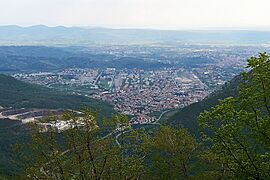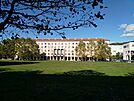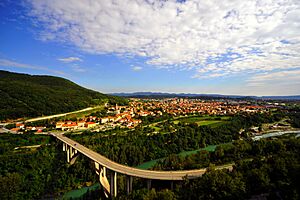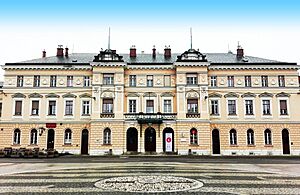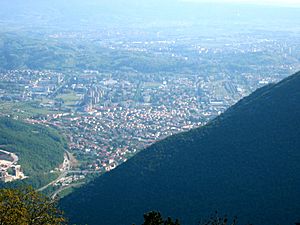Nova Gorica facts for kids
Quick facts for kids
Nova Gorica
|
||
|---|---|---|
|
Town
|
||
|
From top, left to right: Overview of Nova Gorica, Railway station with Square of Europe, Nova Gorica town hall, House with Mehdi Huseynzadeh Memorial, Salvator church, Kostanjevica Monastery on the hill
|
||
|
||
| Country | ||
| Traditional region | Slovenian Littoral | |
| Statistical region | Gorizia | |
| Municipality | Nova Gorica | |
| Area | ||
| • Total | 3.49 km2 (1.35 sq mi) | |
| Elevation | 93.4 m (306.4 ft) | |
| Population
(2023)
|
||
| • Total | 13,021 | |
| • Density | 3,731/km2 (9,663/sq mi) | |
| • Trans-border urban | 71,753 | |
| Postal code |
5000
|
|
| Vehicle registration | GO | |
Nova Gorica is a town in western Slovenia. It sits right on the border with Italy. Nova Gorica is a special kind of town called a planned town. It was built after 1947, when a new border was drawn between Yugoslavia (which Slovenia was part of) and Italy. This new border left the nearby city of Gorizia in Italy.
Because of this, Nova Gorica was created to be the new main city for the surrounding Slovenian areas. It was designed using modernist architecture, which means it has a clean, functional style. In 2025, Nova Gorica and Gorizia together were the European Capital of Culture. Since 2011, Nova Gorica has worked closely with Gorizia and Šempeter-Vrtojba as part of a shared area across the border.
Contents
What's in a Name?
The name Nova Gorica simply means 'new Gorizia'. The word Gorica itself comes from a Slavic word. It means 'hill' or, in older Slovenian, 'vineyard'.
Locally, people often just call the town Gorica. They refer to the Italian city next door as Stara Gorica, which means 'old Gorizia'. You can even see this on Slovenian license plates, where GO stands for Gorica.
A Brief History
After World War II in 1947, a peace treaty changed the borders. Most of the Slovenian-speaking areas that were part of Italy became part of Yugoslavia. However, the city of Gorizia itself remained in Italy.
This new border cut off many Slovenian suburbs from Gorizia, their main city. These suburbs, like Solkan and Šempeter, had about 10,000 people. To connect these areas and create a new center, the leaders of Slovenia decided to build a brand new town. This new town was named Nova Gorica, or "New Gorizia."
The leader of Yugoslavia, Marshal Tito, supported the project. A famous Slovenian architect named Edvard Ravnikar designed the town. Construction began in 1948.

Nova Gorica officially became a town in 1952. It grew throughout the 1950s and 1960s. By the mid-1980s, it had reached its current size. Even though some older suburbs later became separate towns again, Nova Gorica remains an important urban area in western Slovenia.
Climate
| Climate data for Nova Gorica (1991–2020 normals, extremes 1950–2020) | |||||||||||||
|---|---|---|---|---|---|---|---|---|---|---|---|---|---|
| Month | Jan | Feb | Mar | Apr | May | Jun | Jul | Aug | Sep | Oct | Nov | Dec | Year |
| Record high °C (°F) | 19.0 (66.2) |
22.4 (72.3) |
26.5 (79.7) |
30.4 (86.7) |
33.2 (91.8) |
36.4 (97.5) |
38.3 (100.9) |
38.9 (102.0) |
33.5 (92.3) |
29.5 (85.1) |
24.7 (76.5) |
17.9 (64.2) |
38.9 (102.0) |
| Mean daily maximum °C (°F) | 8.4 (47.1) |
10.0 (50.0) |
14.1 (57.4) |
18.1 (64.6) |
22.8 (73.0) |
26.9 (80.4) |
29.4 (84.9) |
29.5 (85.1) |
24.1 (75.4) |
18.8 (65.8) |
13.4 (56.1) |
9.2 (48.6) |
18.7 (65.7) |
| Daily mean °C (°F) | 3.8 (38.8) |
4.9 (40.8) |
8.6 (47.5) |
12.6 (54.7) |
17.1 (62.8) |
21.1 (70.0) |
23.2 (73.8) |
22.8 (73.0) |
17.9 (64.2) |
13.2 (55.8) |
8.9 (48.0) |
4.8 (40.6) |
13.2 (55.8) |
| Mean daily minimum °C (°F) | 0.5 (32.9) |
0.9 (33.6) |
4.1 (39.4) |
7.6 (45.7) |
11.7 (53.1) |
15.4 (59.7) |
17.2 (63.0) |
17.2 (63.0) |
13.3 (55.9) |
9.4 (48.9) |
5.5 (41.9) |
1.5 (34.7) |
8.7 (47.7) |
| Record low °C (°F) | −13.2 (8.2) |
−15.2 (4.6) |
−9.1 (15.6) |
−4.4 (24.1) |
1.0 (33.8) |
5.5 (41.9) |
7.6 (45.7) |
6.5 (43.7) |
2.5 (36.5) |
−3.4 (25.9) |
−7.3 (18.9) |
−10.7 (12.7) |
−15.2 (4.6) |
| Average precipitation mm (inches) | 93 (3.7) |
89 (3.5) |
90 (3.5) |
97 (3.8) |
130 (5.1) |
135 (5.3) |
116 (4.6) |
114 (4.5) |
179 (7.0) |
166 (6.5) |
199 (7.8) |
142 (5.6) |
1,552 (61.1) |
| Average precipitation days (≥ 0.1 mm) | 10 | 9 | 9 | 13 | 14 | 14 | 13 | 11 | 12 | 13 | 14 | 11 | 145 |
| Mean monthly sunshine hours | 105.9 | 131.5 | 173.7 | 192.9 | 235.6 | 258.4 | 303.0 | 287.4 | 200.7 | 150.3 | 98.2 | 96.1 | 2,233.7 |
| Source 1: Slovenian Environment Agency | |||||||||||||
| Source 2: NOAA (sun 1991–2020) | |||||||||||||
Culture and Education
Nova Gorica is home to one of Slovenia's three national theaters. The Goriška Museum is also in the town, located inside Kromberk Castle.
The University of Nova Gorica is in the suburb of Rožna Dolina. The Nova Gorica Grammar School, in the city center, is a very well-known high school in Slovenia.
The cultural magazine Razpotja is also published here. Nova Gorica and Gorizia were chosen together to be the European Capital of Culture in 2025.
Kostanjevica Hill
To the south of Nova Gorica is Kostanjevica Hill. Here you'll find the Church of the Annunciation of Our Lady and a 17th-century Franciscan monastery. This monastery holds many historical treasures.
The last members of the Bourbon family, who were French royalty, are buried in a crypt under the church. This includes Charles X and other family members. They fled France after a revolution in 1830 and found safety in Gorizia.
Sveta Gora
Across from Kostanjevica Hill, to the north, is Sveta Gora. This means "Holy Mount." It's a 682-meter (about 2,238 feet) peak that has been a popular place for pilgrims for 450 years.
From the top, the view is amazing! On a clear day, you can see as far as Istria, Venice, the Dolomites, and the Kamnik and Julian Alps. At the mountain top, there's a beautiful church, a Franciscan monastery, and a museum about the Battles of the Isonzo.
Famous People from Nova Gorica
Many interesting people have come from Nova Gorica.
Arts and Sciences
- Diego de Brea, a theater director.
- Dean Komel, a philosopher.
- Maja Novak, a writer.
- Uroš Seljak, a physicist who studies the universe.
- Marko Peljhan, an artist.
Politics and Public Service
- Robert Golob, the current Prime Minister of Slovenia.
- Borut Pahor, a politician who used to be the president of Slovenia.
- Majda Širca, a film critic and politician.
Sports
- Jure Franko, a ski champion.
- Eva Mori, a volleyball player.
- Matej Mugerli, a road bicycle player.
International Connections
Nova Gorica has special connections with other towns around the world. These are called "twin towns" or "sister cities."
Nova Gorica is twinned with:
 Aleksandrovac, Serbia
Aleksandrovac, Serbia Klagenfurt, Austria
Klagenfurt, Austria Otočac, Croatia
Otočac, Croatia San Vendemiano, Italy
San Vendemiano, Italy Oghuz, Azerbaijan
Oghuz, Azerbaijan
See also
 In Spanish: Nova Gorica para niños
In Spanish: Nova Gorica para niños
- University of Nova Gorica
- Evropski trg


